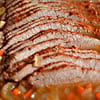The only criterion for fish to be kosher is that it has both fins and scales. This means that anyone who knows the kosher signs can catch their own fish. And, unlike meat and fowl, fish don’t have to be slaughtered or salted, so if the fish you pulled out of the water is a kosher one, you’re good to go!
So what do you look for?
The Talmud notes that any fish that has scales also has fins.1 (For more on this, see Why Aren’t Shellfish Kosher?). So let’s focus on the scales.
The Torah’s word for scales is actually kaskeses,2 which differs from the scientific definition of scales.
What Are Kaskeses?
- They must be visible to the naked eye, not microscopic.3 Thus, for example, a sand lance has tiny scales that aren’t visible, so it’s not kosher. But if the scales can be seen by scraping them off with a rag of a different color, soaking the fish in water, or holding the fish up to the sun, the fish would be considered kosher.4
- They must be easily removable. The Talmud5 notes that kaskeses are referred to as a “garment,” as the verse in Samuel states, “And he was clad with a coat of mail [kaskasim].”6 So the scales must be easily removable—either by hand or with a tool—just as a person can remove a garment with minimal effort.7 If you need to rip the skin to get the scales off, as is the case with bony tubercles and plates, or if the scales are shaped like thorns, as is the case with shark, lumpfish, eel, sturgeon, etc., the fish is not considered to be kosher.
- The fish need not be covered with scales to be kosher.8 Thus, although tuna typically has very few scales, the most common species of tuna is kosher.
- The fish may be born without scales. Fish that develop scales at a later point in life, such as some species of sardines, are still considered kosher, even before the scales begin to grow. And if the scales fall off after the fish is removed from the water, which is the case for some herrings, it’s still considered kosher.9
Swordfish
We mentioned that if a fish grows scales at a later point in life, it’s considered kosher from birth. But what about a fish that loses its scales as it matures?
This was the cause of considerable debate regarding swordfish, which appear to lose their scales as they mature (or at least they become more embedded to the point where they aren’t considered scales).10 Due to this (and various other factors), swordfish are not accepted as kosher by contemporary certifying agencies.
Sturgeon
Looking at a sturgeon, you’ll see what appears to be “scales.” However, they’re classified as “ganoid,” which means that they’re covered with ganoin (similar in texture to fingernails) and cannot simply be removed without tearing the skin.
However, since these scales could be removed using scalding water or an alkaline solution, there was debate about whether or not it should be classed as kosher. The consensus is that it’s not accepted as a kosher fish.11
For this reason, there is no authentic kosher caviar, as it’s made from the roe (eggs) of wild sturgeon.
Problems With Scientific Classification
Science generally classes scales into four main categories:
- Placoid (e.g., shark)
- Cosmoid (e.g., lungfish)
- Ganoid (e.g., bichirs, Bowfin, paddlefishes, gars, sturgeons)
- Cycloid and Ctenoid (most bony fish)
However, as mentioned, these categories were not established based on halachic requirements.
It’s tempting to say that the fourth group—cycloid and ctenoid—are generally kosher. However, this is not always the case. For example, the burbot has deeply-embedded and extremely small cycloid scales, so it’s not a kosher fish.
It’s important to note that once the fish has been skinned, it’s almost impossible to ascertain what type of fish it is. This is recognized by the FDA, which warns that species substitution is a very serious problem.
Even if someone tells you the name of the fish, you still may not know if it’s kosher, for there are a number of different species of fish that are referred to by the same name. And even familiar fish such as tilapia, tuna or red snapper can all refer to either kosher or non-kosher varieties.
So if you catch (or purchase) a fish you’re not familiar with, the way to tell if it’s kosher is to pick off a scale and see if it peels off easily.
Happy fishing!







Join the Discussion